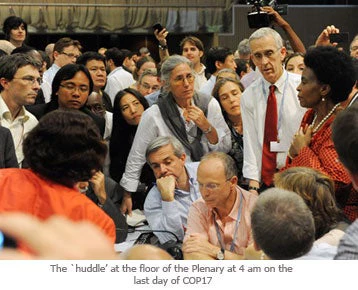At 4.30 on Sunday morning, after 36 hours of overtime (a record), the 194 country members of the UNFCCC pulled a rabbit from the hat. Special flights had been put on by South African Airways as a way to encourage delegates not to leave.
Putting the Puzzle Together
Three big pieces of the jigsaw needed to fall into place in order to clinch the `Durban Platform’. First, a new commitment period of the Kyoto Protocol, without which developing countries would have walked. Second, a road map towards a truly global deal to be effective by 2020 at the latest, without which the EU wouldn’t sign on to a new Kyoto. Third, the launch of the Green Climate Fund, without which developing countries wouldn’t sign on to such a global road map.
Putting the pieces together required compromise and was accompanied with brinksmanship, emotion, and millions of words spoken, usually repeating what had already been said. The outcome, however, is highly positive for the long term prospects for a deal, and delivered all that could reasonably be hoped for (see my earlier blog: Will Durban Deliver?).
Thus, in a nutshell, delegates left Durban having agreed on:
- A new commitment period under Kyoto for the EU and 11 other countries beginning January 1, 2013.
- An agreement to negotiate a global deal by 2015, which would be effective from 2020 with "legal force" applying to all countries.
- A Green Fund launched, with regional groupings to nominate board members in the coming three months. Board selection will be very important since most operational details yet to be designed.
The Meat and Potatoes
In addition, it was decided that:
- A technology mechanism will be launched in 2012 – to assist developing countries build capacity and gain access to climate friendly technologies;
- The Adaptation Framework will become operational in 2012, providing guidance and advice on national adaptation plans etc.
- Agriculture will be addressed under the Convention through work under the Scientific and Technical body (SBSTA), which is potentially very good news for the world’s small farmers;
- A Registry of developing country mitigation plans (NAMAs) will be set up in the coming year;
- Carbon markets to be continued (boosted by the KP decision), CDM simplified, and a new market mechanism taken forward.
- Improved rules for REDD+, facilitating financing, safeguards, and reference levels.
Was it Enough?
With all these positive results, why then was the Durban Platform not marked by the same euphoria as was the Cancun decision last year? And why did many developing countries leave Durban with a feeling of disappointment? Partly exhaustion. But mainly because every delegate knew that these decisions will have relatively little impact during the current make-or-break decade, and there was a feeling that we may be leaving things too late.
Fortunately, the real world of action forced itself into the Durban discussions, providing some hope in the years until a global regulations come into force in 2020. (Part 2 to come later this week)
(Watch Andrew Steer discussing World Bank taking action on climate change here)



Join the Conversation